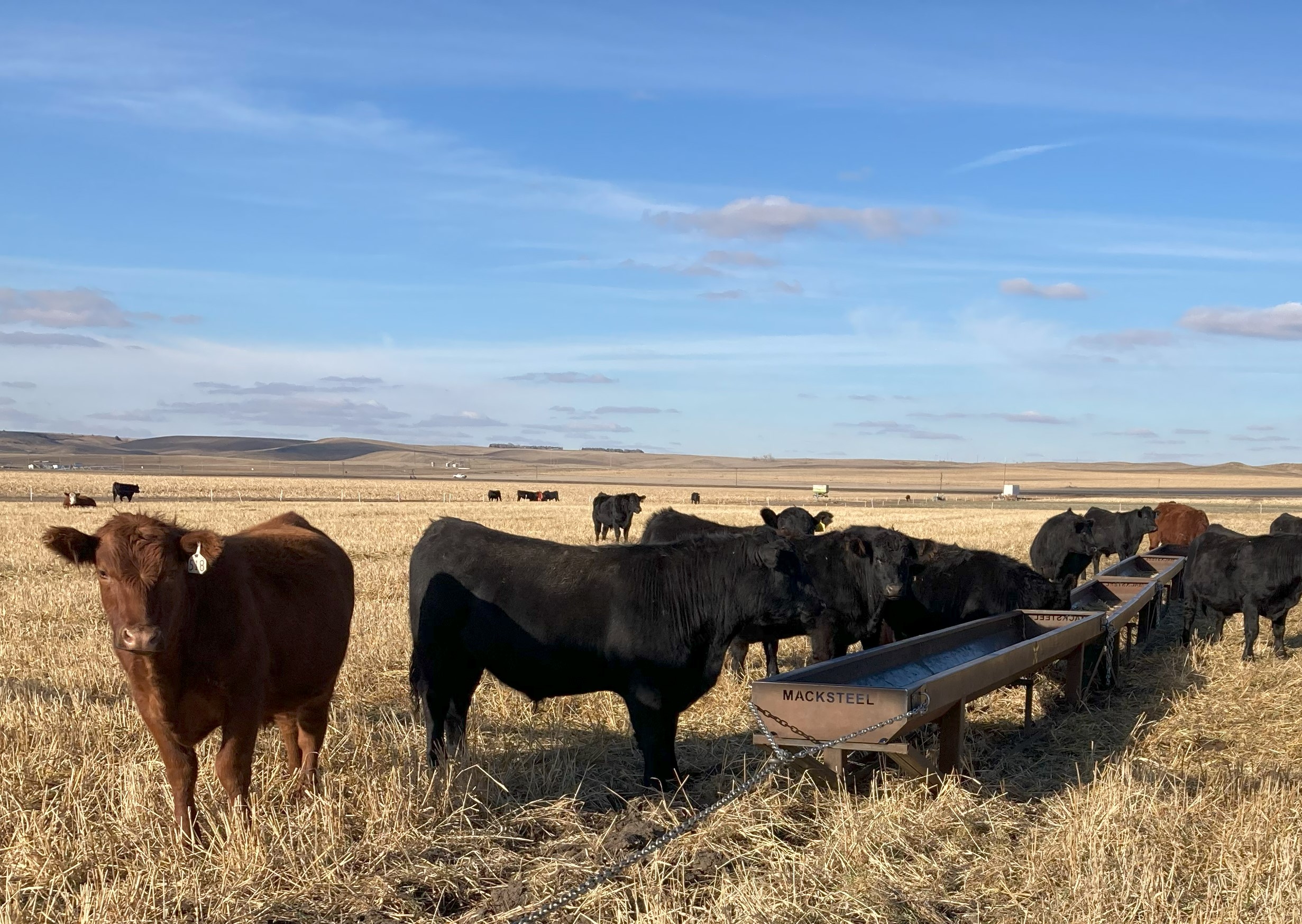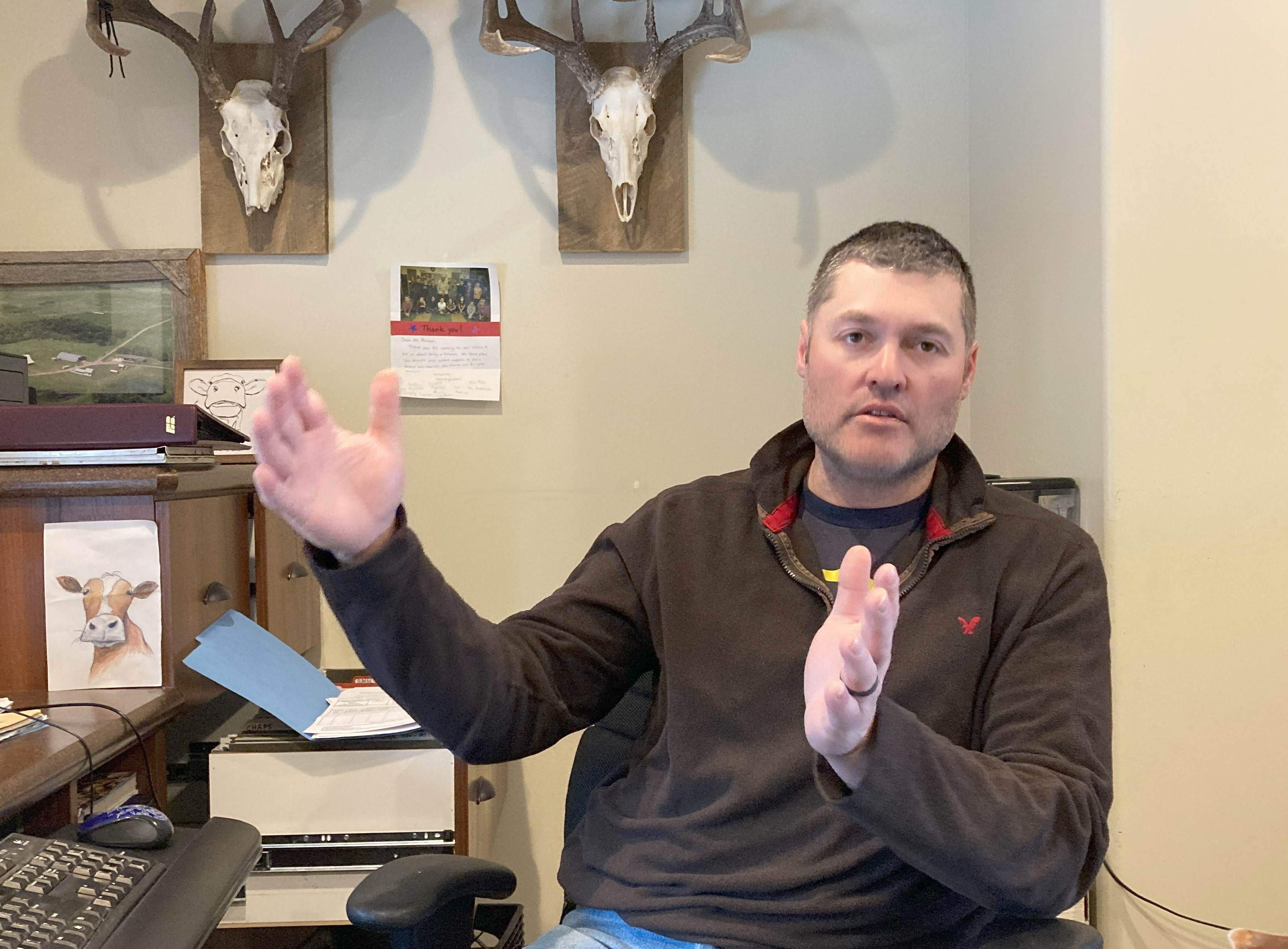Fall Cover Crops Provide Viable Grazing Program for Stocker Cattle
Monday, February 12, 2024

By Julia Gerlach
Cover crops are frequently praised for improving soil function, reducing erosion, and suppressing weeds, along with the other soil health benefits they provide. But finding a way to convert them from an expense to a profitable enterprise can sometimes prove elusive. For producers with cattle, however, the formula is easier to pencil out.
For Luke Perman, a Lowry-area rancher, a cover crop grazing demonstration conducted at Dakota Lakes Research Farm this fall provided just the insights and evidence he needed to boost his confidence in putting together a fall cover crop grazing plan for his yearlings in 2024.
Demo Details
 For the program, Perman sent 67 yearlings to Dakota Lakes on Oct. 4, 2023, averaging 823 pounds when they arrived at Dakota Lakes.
For the program, Perman sent 67 yearlings to Dakota Lakes on Oct. 4, 2023, averaging 823 pounds when they arrived at Dakota Lakes.
Perman’s animals, along with 12 stockers belonging to Dakota Lakes, were put out to graze a field of cover crops (oats and triticale) and an adjoining field of corn stalks. The cover crops had been swathed and allowed to regrow, so the animals had access to the swathed cover crop, cover crop regrowth, and corn stalks. In addition, for the final six weeks of the demo, the animals also received supplemental feed to the tune of 2.5 pounds per head per day and increasing to 17 pounds per head per day by the end of the demo. The grain was provided in custom-made movable bunks connected to an irrigation rig. The bunks were moved 90 feet every day and a hot wire hung from the irrigator kept the animals contained.
.jpg) According to Cody Zilverberg, consulting scientist for Dakota Lakes, the purpose of the demonstration was to “learn how much weight the animals could gain on the feed we had available, specifically cover crops, crop residue, and supplements like flaxseed meal and corn grain.”
According to Cody Zilverberg, consulting scientist for Dakota Lakes, the purpose of the demonstration was to “learn how much weight the animals could gain on the feed we had available, specifically cover crops, crop residue, and supplements like flaxseed meal and corn grain.”
When the animals were sold on Jan. 5, 2024, they averaged 1,024 pounds.
“They gained 2.2 pounds per day. That’s not bad, but I think we could have done better if we had begun feeding corn and flaxseed meal sooner,” Zilverberg says, adding that for Dakota Lakes the program was informative though not profitable for them, and exposed several ways in which the program could be improved.
“We’re still trying to find better ways to feed hay on crop fields without wasting so much. It’s expensive to waste hay, but it also causes uneven amounts of residue in a crop field which makes seeding next year’s crop more difficult. We fed into mobile bunks using a bale processor. The processor isn’t really made to do this, so we spilled a lot on the ground,” he says.
Better Gain on Covers
For Perman’s part, he was very pleased with the study, as he says it provided a concrete example of how he can successfully graze cattle on cover crops in the fall.
“It gives me the confidence to plan some of these season-long cover crops and have some expectation of what the cattle will gain through the fall,” he says.
In addition, the results of this demonstration helped him understand how to better utilize resources on his operation.
“In the past, we’ve put cows out on cover crops after weaning and they put on good fat for the winter, which is good but it’s not always necessary. A dry cow in early to mid-gestation doesn’t need to be that fat -- she just needs to get through the winter. I don’t get paid for those pounds,” he says. “But if I can turn a yearling out there and they continue to gain 2.2 pounds a day and the value of that gain is $1.50 to $1.75, I’m getting paid for those pounds and it’s turning into money in my hand when I go to sell them.
“That’s where I see this being something that I can make money on going forward because rather than selling yearlings in August, we can just continue to have them gain on a high-quality forage, which is really too good for anything else that I own. I’ve grazed pairs on them before and that works. But I like the yearling model because we can go to those season-long or full-season cover crops in August when the grass is starting to dry up and decrease in quality and we can keep the yearlings gaining pretty good.”
Prior to being shipped to Dakota Lakes for the study, Perman’s Angus yearlings, born in May and June of 2022, were on pasture from May through mid-August. He says while he doesn’t have exact figures, he believes the animals were gaining about 1.6 to 1.7 pounds per day on pasture. So, the 2.2 pounds per day on the cover crops and supplemental grain was a definite improvement. Perman paid Dakota Lakes $1.25 per pound of gain to have his animals grazing on their land.
Besides the impressive gain his animals experienced on the cover crops from October through December, Perman says another benefit of the season-long cover crops is that they allow him to keep livestock off his pastures during those fall months.
“In September, the cool season grasses, like Western Wheatgrass, are on the second part of their growth curve and they’re getting ready for the following year, putting on their reserves,” he says. “So, I don’t really want to graze them in September. If I could get every animal off the perennial pastures in September and October, I’d do that. Because that’s going to help me next year when I try to start grazing around March 1 on pasture.”
Perman aims to move his livestock once or twice a week, and he manages his grazing around his cow/calf pairs, basing when and where he grazes yearlings on when and where he will be able to put his pairs.
“For example, if I know the pairs aren’t going to get to a certain pasture until August 15, I know that I can put my yearlings in there in May or June for a little while and graze it lightly knowing that it’s got time to recover,” he says. “So, I’m trying to use the yearlings to manage the grass ahead of the cows. I’m trying to use them to get to the places the cows either can’t get to at all because of the logistics of getting there with calves or to set it up for the cows later. Because then it’s better quality for the pairs when they come in because it’s regrowth rather than dried up old mature grass.”
To get the cover crop grazing system to work, Perman aims to have the warm-season cover crop planted by June 10. In 2024, he says he intends to plant about 350 acres to that cover crop. He hasn’t nailed down the exact mix or seeding rate yet, but he says it will definitely contain a forage sorghum as a significant portion of it.
“Sorghum produces a lot of forage and it is good quality,” he says. “I want to put other stuff in there too because I want a lot of diversity and I want to have it tailored to the field as well as when we’ll put the animals out there. But I haven’t figured out exactly what that mix will be yet.”
Perman no longer follows the traditional practice of winter calving, having shifted to a later calving May to June window in 2015, primarily to reduce labor constraints. But he says there are economic benefits to later calving as well, including:
- He doesn’t have to maintain as good a quality of diet through the winter as he would if they calved earlier.
- Later calving is less dependent on facilities – he doesn’t need a barn as the animals can safely calve in the pastures.
- The value of gain on a 700 to 800 pound calf doesn’t compare favorably to the value of a 500 pound calf. “If you’re only going to get paid 50 cents a pound for those extra 200 pounds but it costs you $1.50 to get them there, it doesn’t make sense,” he says. “We just have to understand that we’re not going to sell them in October because they’ll only weigh 400 or 350 pounds at that time.”
Categories: News